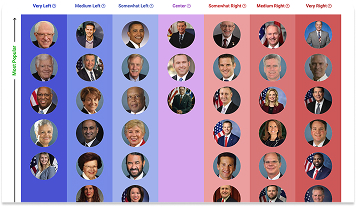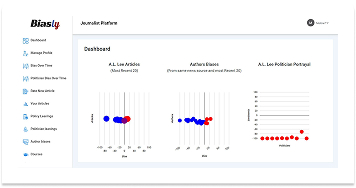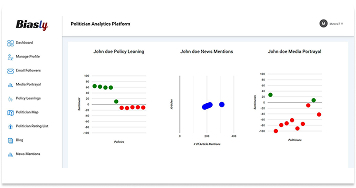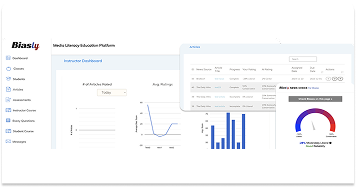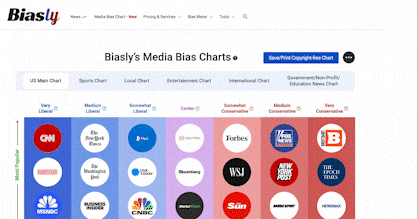Bias Meter
Extremely
Liberal
Very
Liberal
Somewhat Liberal
Center
Somewhat Conservative
Very
Conservative
Extremely
Conservative
-100%
Liberal
100%
Conservative
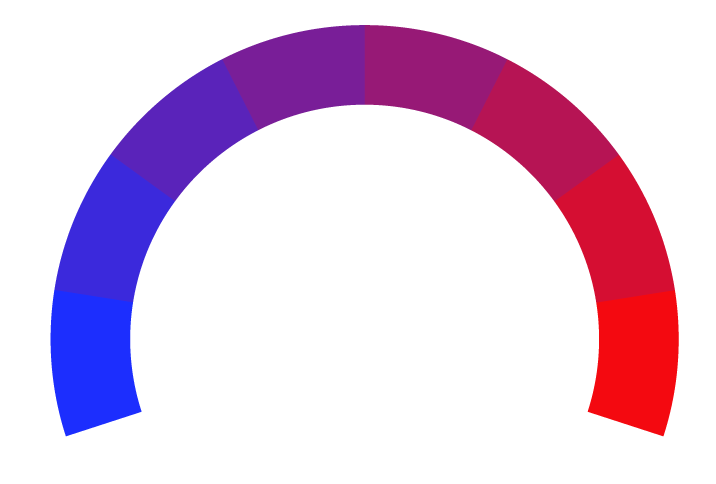
Biasly determines media bias ratings through a dual-layered approach combining artificial intelligence and analyst review. The platform’s proprietary bias detection engine, Bias Meter, evaluates sentiment, policy position alignment, and language framing across thousands of data points in news articles. Analysts then verify and interpret the AI’s findings, providing additional context where needed. Learn more
- Profile
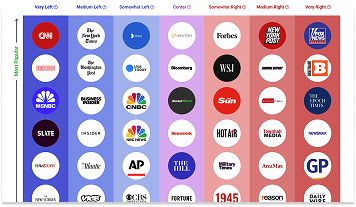
Consortium News on the media bias chart
Consortium News has a Bias Score of -14% Somewhat Left which is based on a variety of factors including its policy and politician leanings, article ratings, and the use of biased language. Its Reliability is rated as Average, and additional analytical insights are available in the other tabs.
- Bias Rating
-14% Somewhat Left
- ReliabilityPolicy Leanings
18% Somewhat Right
Extremely
LiberalVery
LiberalModerately
LiberalSomewhat Liberal
Center
Somewhat Conservative
Moderately
ConservativeVery
ConservativeExtremely
Conservative-100%
Liberal100%
Conservative
Average Reliability
*Our bias meter rating uses data science including sentiment analysis, machine learning and our proprietary algorithm for determining biases in news articles. Bias scores are on a scale of -100% to 100% with higher negative scores being more liberal and higher positive scores being more conservative and 0% being neutral. The rating is an independent analysis and is not affiliated nor sponsored by the news source or any other organization.
Politician Portrayal91% negative
Continue For Free
Create your free account to see the in-depth bias analytics and more.
By creating an account, you agree to our Terms and Privacy Policy, and subscribe to email updates.
Policy Leanings Analysis
Policy | Bias score |
|---|
Consortium News Editorial Patterns
Consortium News’ coverage of political topics often reflects a Somewhat Left bias, with consistent patterns in phrasing, source selection, and thematic focus that are Lean Left. While the publication demonstrates journalistic standards in many of its reports, the choice of issues, framing, and word usage can indicate a political slant. This content analysis examines how the Consortium News handles liberal and conservative issues and evaluates its language choices and editorial tendencies.
Coverage of Liberal vs. Conservative Topics
Consortium News provides extensive coverage of left-leaning topics and often gives a righteous view on them. One such article by Jake Johnson, covering criticism of Trump’s thought of openly supporting Israel in the Israeli-Iranian conflict. Critics of this idea are often left-leaning, with many progressive and liberal voices directly opposing the possible use of war powers. Most opponents of supporting Israel identify as left-leaning and are more likely to support nations’ right to defend themselves, like in Palestine or, in this scenario, Iran.
The article overwhelmingly provides the left-leaning view on this topic, with a few interjections of a more right-leaning view. The article mostly provides quotes from opponents and states that Trump’s potential actions would be wholly illegal.
Consortium News does provide some articles on right-leaning topics, such as the de-escalation of the Russo-Ukrainian conflict. In the article titled ‘Rooting Out the Root Causes in Ukraine,’ writer Joe Lauria takes a wholeheartedly supportive position of President Donald Trump and Vladimir Putin’s shared belief that the root cause of the conflict is the expansion of the North Atlantic Treaty Organization (NATO) and the American backed Ukrainian government change in 2014, which Lauria compares to Russia theoretically backing a coup in Canada or Mexico.
The article takes an unmistakable stance against the left-leaning belief that Russia is the aggressor in the conflict. Lauria, in no uncertain terms, states his support for Putin and Trump’s attempts at peace through “resolving” the “root causes.”
Notably, Lauria makes use of quotes throughout the article to articulate his point. When taking quotes from the debate, Lauria indents and makes quotes from Trump and Putin visible, while simply putting Ukrainian President Zelensky’s quotes in body paragraphs.
Policy and Issue Framing
The Consortium News overwhelmingly covers left-leaning topics, such as anti-ICE protests and support for Palestine. As for Israel, the Consortium News often depicts Israel as the unequivocal aggressor, with one article saying that the attacks on Iran were “unprovoked” and “risks major war in the Middle East.”
The Consortium News infrequently talks about right-leaning issues such as the de-escalation of the Russo-Ukrainian War and gun control. The Consortium News often takes a critical stance on the 2nd Amendment’s right to bear arms, stating that it is simply a part of toxic gun culture that claims victims.
Coverage and Relevance
The Consortium News provides extensive coverage of “anti-imperial” movements around the world, particularly the Palestinian conflict. Much of their coverage lies in left-leaning and socialist ideas, often opting to portray those ideas as inherently correct or righteous.
Consortium News notably provides extensive coverage of Act Now to Stop War and End Racism (ANSWER), the People’s Forum (PF), and the Socialist and Liberation Party (SLP) panels and events. PF and SLP both identify as socialist organizations, and thus cover many working-class and civil rights issues. ANSWER identifies as anti-imperialist and thus focuses on organizing protests against US intervention in the Middle East, more recently focusing on Palestine, Lebanon, and Iran. Because the Consortium News provides extensive coverage of these organizations, it also extensively covers these topics.
Consortium News Bias Analysis
Is Consortium News Biased?
Based on Biasly’s evaluations, Consortium News is rated as Somewhat Left.
Consortium News prides itself on its independent founding. To this day, the Consortium News considers itself a bastion against mass media and a symbol of true journalism. Per the Consortium News, mainstream media have grown untrustworthy, rampant with American propaganda, and are susceptible to partisan influence.
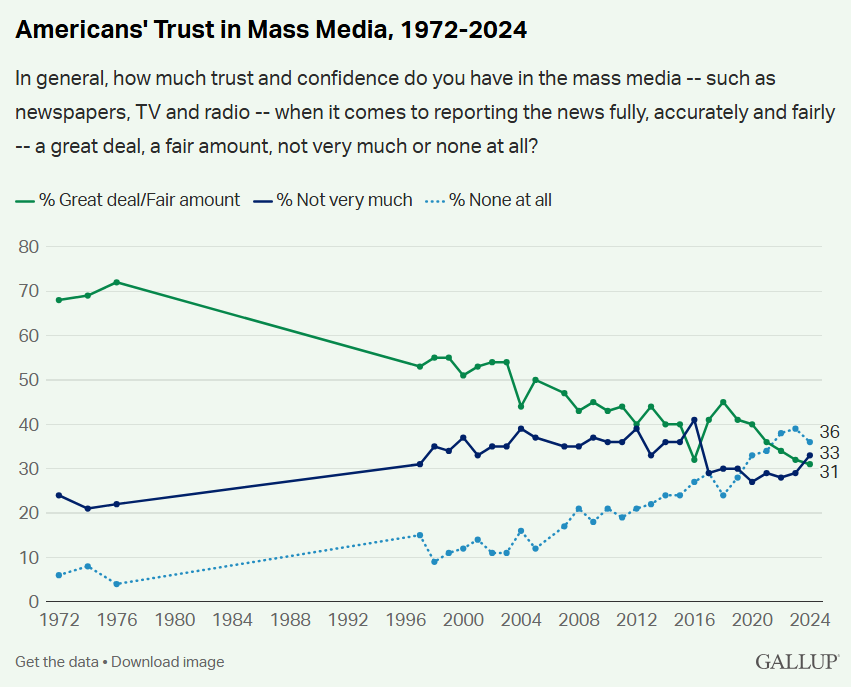
Source: Gallup
This type of rhetoric isn’t uncommon, as the above poll shows a shift away from mainstream media. Through analyzing the Consortium News’s boast of being independent, we can analyze the type of audience that it attracts and the issues that it would cover.
Through examining Consortium News articles, we can assess their political biases. Analyzing content patterns allows us to contribute to the ongoing discussion about bias in the news.
How Does Biasly Rate News Sources?
Biasly uses proprietary algorithms and a team of analysts to provide comprehensive bias evaluations across thousands of news outlets. Over 200,000 articles from more than 3,200 sources have been analyzed to identify the most accurate and unbiased stories.
Biasly assigns each outlet three key scores:
- Reliability Score – Reflects factual accuracy
- AI Bias Score – Generated via natural language processing
- Analyst Bias Score – Assessed by human political analysts
These scores are based on seven core metrics: Tone, Tendency, Diction, Author Check, Selection/Omission, Expediency Bias, and Accuracy. These elements help analysts and algorithms evaluate the political attitude conveyed by each article.
Biasly’s Bias Meter ranges from -100% (most left) to +100% (most right), with 0% indicating neutrality. The system evaluates individual articles based on political terms, policies, figures, and sentiment to calculate precise bias ratings.
Is Consortium News Politically Biased?
Consortium News earns Somewhat Left rating for its AI Bias Score, and Somewhat Left for its Analyst Bias Score. The Analyst Bias Score is generated by reviewers from liberal, moderate, and conservative backgrounds. Analysts reviewed 15 Consortium News articles and noted preferences in areas like coverage of liberal politicians and policy topics such as abortion rights and clean energy. However, the paper maintained objectivity on topics like education and national security.
For example, coverage of racial minorities and affirmative action laws reflects a mostly neutral tone. But articles involving ‘Black Lives Matter’ contributed significantly to the liberal score, with a Somewhat Liberal bias.
Before analyzing the articles and specific political bias, we must first analyze the impact that the type of journalism has on the bias. Because the Consortium News tends to be independent and thus anti-institutionalist, there can be an argument made for a lean toward each side.
For a left-leaning bias, one can cite systematic racism and anti-communism/socialism rhetoric prominent in American government and society. These topics are inherently left-leaning topics that go against the status quo and argue systematic corruption.
For a right-leaning bias, one can cite government interference and government regulation. These topics are inherently right-leaning, as the right is far less likely to support government intervention, instead supporting the regulation of government.
Analysis of Bias in Consortium News Online Articles
Consortium News often speaks on the bias inherent within mainstream media and the Consortium News’s goal to rise above it. However, leading up to this point in this article, there have been certain concerns surrounding the bias within the Consortium News. Thus, the question must be asked: How does Consortium News fare in terms of bias?
To evaluate this, we can analyze select Consortium News articles through several of Biasly’s bias rating criteria: Tone, Tendency, Author, Diction, and Expediency Bias.
- Tone: Overall emotion and attitude portrayed in the article
- Diction: Word choice and vocabulary used in the article
- Author: The author’s personal biases and history
- Tendency: The author’s common patterns in other works
- Expediency Bias: Easily visible quotes, paragraphs, or images; often related to ‘Clickbait’
It must be noted that the Consortium News does not clearly distinguish opinion pieces and non-opinion pieces. While many opinion pieces will include the writer’s name in the title, that is not always the case. Through analysis of article titles and wording, you can identify non-opinion articles. However, it must be noted that there are few non-opinion articles.
One can analyze non-opinion articles to determine the bias of Consortium News. One such article is “US Reps Seek ‘War Powers’ for Trump’s War With Iran”. This article explores the bill proposed in the House of Representatives by Representatives Thomas Massie (R-KY) and Ro Khanna (D-CA) that would prevent President Donald Trump from involving the United States in the Israeli-Iranian conflict.
The tone throughout the article takes a negative view on Trump’s strikes on Iran, but does not explicitly say so. Instead, Wilkins shows the tone through displaying overwhelming support for the bill by showing pictures and X posts from proponents of the bill. The article is littered with quotes from figures expressing their support for the bill and even displays a clip from the left-leaning satire show, The Daily Show. Thus, the tone of the article is critical of Donald Trump and displays support for the bill.
However, the article falls short because it does not display the voices of opponents to the bill, featuring only a short clip of Donald Trump speaking on the situation. It is important to show both sides of the debate. If an article does not, it may not include all relevant information, possibly misinforming readers.
Throughout the article, Wilkins is careful with the words that he uses. There are few instances where Wilkins uses distinctly negative or positive wording.
However, one such instance in which Wilkins uses negative words is when he describes Trump speaking on Iran. Wilkins states that Trump has “ratcheted” up “cryptic threats” against Iran. When Wilkins says “cryptic threats,” he is implying that the threats are negative or deliberately unclear, generally a negative portrayal of a politician. When he says “ratcheted,” he is implying that Trump is giving those threats in a ‘trashy’ or ‘undignified’ way.
When looking into the history of Wilkins, we can find that he generally left-leaning history. Wilkins has worked for other journalist agencies that tend to be left-leaning. Most notably, much of his work is based around anti-war movements, which can signify his bias when talking about the bill in the article and depicting overwhelming support.
Wilkins isn’t active on social media, but some of his posts on X in the last year depict his hatred for war in the Middle East. One post praises historical LGBTQ+ protests, equating them to the left-leaning protests against Israel, detailing the situation as “Israel’s [G]aza genocide”.
Wilkins’ LinkedIn ‘about’ section describes him as an ‘activist‘ for human rights, which is generally a left-leaning movement.
Overall, the article does a decent job of being unbiased, but its biggest downfall is that it does not show both sides of the debate. Despite Wilkins’ background in left-leaning activism, he generally uses neutral language effectively in the article, with only one instance where he employs negative language.
Analysis of Consortium News Opinion Articles
To best analyze the non-opinion articles, you must also analyze how they write opinion articles. Opinion articles will give the unfiltered opinion of writers, which generally reflects the views of the news agency.
Because Consortium News features a high proportion of opinion articles, this section effectively highlights the bias in the agency. The article that best depicts the bias in Consortium News is titled “Rooting Out the Root Causes in Ukraine” by Joe Lauria, editor-in-chief of Consortium News.
As editor-in-chief, Lauria is in a unique position to control the beliefs and narratives published to the Consortium News. One can analyze his social media posts, however few they are, to get an easy idea of his beliefs. One post to his X account satirically gives a multiple-choice question on “who wrote [Ukrainian president] Zelensky’s speech.” All the choices imply that Zelensky is simply a puppet of the United States. Another post shows a political cartoon, satirizing a travel promotion poster to Gaza, showing a moped with the Israeli flag driving over human skulls.
The article takes a critical tone when analyzing the root causes of the conflict, exclusively blaming NATO and other Western countries for provoking Russia into the invasion. Lauria blames Ukraine for the conflict, pleading for them to surrender to Russia and hoping to set conditions.
When speaking on Russia’s invasion of Ukraine, Lauria calls it an “intervention” in Ukraine’s “ongoing civil war.” This brings up positive emotions and presents Russia as the savior of Ukraine and not the invader. When talking about NATO’s involvement in Ukraine, Lauria uses words such as “expansion” while claiming there to be a large neo-Nazi presence in Ukraine, but does not provide evidence for the latter.
Who Owns Consortium News?

Source: Consortium News
Consortium News is a website published by the Consortium News for Independent Journalism, Inc., by Robert Parry in 1995. Parry founded the Consortium News because he believed that mainstream media had become a voice piece for American propaganda. He believed that there needed to be more independent journalists. He believed that less independent journalism makes people susceptible to propaganda and ‘false history’.
Robert Parry, who at the time worked for the Associated Press (AP), is credited with helping expose the Central Intelligence Agency (CIA) and Contra scandal in the 1980s. Parry states that witnessing the cover-up and the influence the American government had on news organizations, like the Associated Press. As he stated on the Consortium News ‘About’ section:
“As one of the reporters who helped expose the Iran-Contra scandal for The Associated Press in the mid-1980s, I was distressed by the silliness and propaganda that had come to pervade American journalism. I feared, too, that the decline of the U.S. press foreshadowed disasters that would come when journalists failed to alert the public about impending dangers.”
Since its creation, the Consortium News has been led by the Board of Directors, with Robert Parry being its president until his death in 2017. Following his death, his wife, Diane Duston, became the president of the board. She still holds this position today.
The members of the Board are typically authors and other journalists. However, there are two known politicians: the late democratic Senator Mike Gravel and Jill Stein, the Green Party’s presidential nominee since 2012.
Notable people associated with the Consortium News include Vijay Prashad, Christopher Hedges, and Dr. Noam Chomsky. Prashad and Hedges have openly stated that to be socialist revolutionaries. Dr. Noam Chomsky, however, has been ambiguous about his political leanings, but is rumored to be at least a form of socialist.
Consortium News has received a donation from Roger Waters, co-founder and bassist for the band Pink Floyd. It is noted that Roger Waters has endorsed socialism, with him saying socialism is “a good thing” while calling for universal healthcare, a common policy among much of the left.
How to Evaluate Bias
Although Biasly rates Consortium News as Somewhat Left, it’s important to remember that bias can vary from article to article. Consortium News also covers a conservative-leaning state with objectivity on many issues, from state legislation to social developments. This complexity underscores the importance of examining each article individually. So, let’s learn how to evaluate media bias.
Recognizing media bias requires awareness and critical thinking. Often, readers trust news sources that affirm their existing beliefs—a psychological tendency known as confirmation bias. This makes it harder to identify slanted narratives or one-sided reporting.
To combat this, it’s essential to challenge your assumptions by consulting multiple viewpoints and verifying news through third-party analysis. Tools like Biasly’s media bias ratings allow readers to compare the same news story across the political spectrum.
Ultimately, bias isn’t always a matter of what is said—it’s also about what is left out, how topics are framed, and which stories are chosen for coverage. Learning to recognize these patterns can help readers make more informed decisions and develop greater media literacy.
To start comparing news outlets and gain a better understanding of bias, sign up for Biasly’s Media Bias & News Analytics Platform to see how stories vary between sources.
Consortium News Reliability Analysis
Is Consortium News Reliable?
There are many concerns about Consortium News’ reliability. Some say Consortium News is simply a mouthpiece for Russia and others who believe they leave facts out of the equation.
Consortium News typically boasts that it goes against mainstream media and the establishment. However, does going against the establishment mean they still keep up with the standards of reliability?
How to Evaluate Reliability?
Reliability refers to how trustworthy or accurate a news source is. If we can’t trust what we read, then continuing to consume content from that outlet serves little purpose. So, how do we evaluate a news outlet’s reliability?
There are several potential measures of reliability to look out for when trying to determine whether a media source is reliable or not. Red flags for an unreliable article can include the presence of wild, unsubstantiated claims, facts dependent on other unreliable sources, heavy use of opinionated language, and more. In contrast, hallmarks of a reliable source include:
- Absence of subjective language
- Citing credible sources (e.g., .gov, .edu, academic references)
- Verifiable facts and statistics from multiple outlets
- Use of primary sources, like interviews or transcripts
- Consistency with coverage across other platforms
Biasly’s reliability scores incorporate these elements in evaluating media outlets.
So, How Does Consortium News Fare in Its Reliability?
The political reliability index developed by Biasly assesses both accuracy and trustworthiness. Consortium News currently holds Average Reliability Score, which is calculated as a weighted average of:
- Fact Analysis Score – Evaluates the accuracy of claims, facts, and evidence.
- Source Analysis Score – Assesses the number, diversity, and credibility of sources and quotes used.
Consortium News’s Source Analysis Score is rated Average at 63%. This suggests moderate trustworthiness in its sourcing practices. The score is AI-generated and considers quote length, frequency, diversity, and quality.
The Fact Analysis Score has yet to be finalized. This score will further determine how well the Consortium News supports its claims, addresses selection and omission bias, and presents verifiable evidence. Until this is available, readers are encouraged to perform their evaluations using Biasly’s media bias tools.
While the majority of Consortium News’ articles will contain factual information, they often omit relevant information. Among the biggest concerns regarding reliability is when Consortium News discusses the Russo-Ukrainian conflict or the Middle East.
According to Biasly’s analysis, Consortium News maintains Average Reliability Score, but individual articles may vary significantly. Let’s dive into the details.
When one analyzes a source’s bias, they typically analyze the source’s reliability in connection with its political affiliation. For example, a source that is rated left-leaning will be prone to including liberal sources and excluding conservative sources.
Two common types of bias that affect factuality include:
- Selection Bias – Highlighting or omitting stories to fit a particular narrative.
- Omission Bias – Leaving out differing perspectives or relevant details to skew perception.
Biasly’s accuracy ratings use a scale from 1% (least accurate) to 100% (most accurate). Factors include the presence of supporting evidence, internal and external reliable sources, and balanced viewpoints.
For instance, Biasly gave the BizPac Review a Somewhat Conservative Bias and an Average Analyst Reliability Score. One BizPac article, titled “Chris Cillizza says corporate media was ‘too willing’ to buy Biden team’s line that he was fit as a fiddle”. This article showed an Average reliability rating for failing to include diverse viewpoints and for employing inflammatory language. Critical language towards Joe Biden did not stop at the headline either. Reporter Jason Cohen failed to complement his selection of conservative opinions with views belonging to any other school of thought. In contrast, another piece from the outlet, titled “SCOTUS will hear case that could result in country’s first taxpayer-funded religious charter school.” The article features legal and political sources with balanced quotes. This article was rated as Center and scored high for accuracy. The most significant language opposing liberal views here belongs to a politician, whose position naturally required involvement with local education systems. Vivex Saxena reported:
“The plan is supported by Oklahoma State Superintendent Ryan Walters: The problem is that charter schools are considered public schools by default.”
This quotation is characteristic of Saxena’s writing throughout the article. Therefore, she received Good and Excellent reliability ratings on Biasly.
We will take a closer look at more examples like this below to provide a further investigation into the reliability of Consortium News’s articles. This will include its use of selection bias, omission bias, and the quality of its sources and the facts it uses.
Analysis of Reliability in Consortium News’s Online News Articles
Consortium News’ primary goal is to provide factual, independent reporting that is outside the influence of mainstream media. Their writers are overwhelmingly left-leaning. Notable among their Board of Directors are Green Party’s Jill Stein and Chris Hedges, an admitted socialist.
But just because there are significant left-leaning figures in Consortium News does not necessarily mean they let their biases influence their work or news reporting. After all, everybody is biased in some way.
Thus, it is essential to analyze the quality of sources and the reliability apparent in the Consortium News’s articles.
Quality of Sources and Facts Used
Consortium News has mixed results when providing a variety of sources. Thus, when analyzing articles from the Consortium News, one must carefully analyze who is writing the article and the sources used.
Some articles, such as the previously mentioned “US Reps Seek ‘War Powers’ for Trump’s War With Iran”. The article overwhelmingly include voices that support the legislation and do not provide voices that oppose the legislation.
Other articles, such as “Rooting Out the Root Causes in Ukraine,” provide very few in the way of sources, yet make many arguments. This article provides quotes from Vladimir Putin, Donald Trump, and Volodymyr Zelensky. However, these quotes only relate to the recent conversation between Putin and Trump. The only sources that are cited when discussing the root causes of the Ukraine conflict are other articles written by Joe Lauria.
Some articles, such as “Ukraine Timeline Tells the Tale” by Joe Lauria, provide a plethora of sources from across the spectrum.
These sources are as follows:
- Wikipedia, a popular online encyclopedia.
- Government report, discussing CIA work with neo-Nazis or similar
- A video posted on X, formerly Twitter, of, at the time, Senator Joe Biden arguing that NATO expansion will provoke Russia
- Zbigniew Brzezinski, former U.S. National Security Advisor.
- A NATO conference in Bucharest is talking about possibly inviting Ukraine and Georgia into the alliance.
- WikiLeaks, a popular online encyclopedia of leaked or legally acquired government documents
- Kremlin website, Russia’s capital complex.
- Organization for Security and Cooperation, stating that the president of Ukraine was fairly elected
- John Kerry, United States Secretary of State
- The United Nations endorsed the Minsk Accords II
- BBC report on the US “activate(s) Romanian missile system”
- The Guardian reports on “war games” near Russia’s borders
- Frank Walter-Steinmeier, Germany’s foreign minister.
- Responsiblestatecraft.org, an online news website.
- Antiwar.com, a left-leaning activist website.
Notably, this timeline includes a large variety of sources on either side of the debate. It also notably includes neutral and reliable government organizations. However, Lauria makes numerous claims during this timeline, but does not provide a source or evidence for half of these claims.
Notably, Lauria writes this article as a factual and historical timeline, but none of the sources he uses are from certified historians. Further, Lauria often uses quotes from the opinions of figures, and thus draws his conclusions from these quotes as inherently factual.
“‘We have the right to ask: against whom is this [NATO] expansion intended? And what happened to the assurances our Western partners made after the dissolution of the Warsaw Pact? Where are those declarations today? No one even remembers them.’
…The West humiliates Putin and Russia by ignoring its legitimate concerns.”
Overall, there is much left to be desired when analyzing sources. There certainly are factual sources that come from opposing sides of the debate. However, Lauria takes his opinions on some of these sources as inherently factual. Sometimes he fails to provide evidence for his claims at all. Lauria also fails to consult professionals related to this field.
Lauria also seems to build himself up as one of the only people to take a stand against “war propaganda” in mainstream media. He portrays himself as righteous and compares himself to historians who analyzed the root causes of World War Two. This comparison may be problematic, as he does not have a degree in history or published peer-review historical works.
Overall, the quality of sources and facts used in this article is inconsistent, and Lauria puts too much weight behind his conclusions and opinions.
Selection and Omission Bias
The Consortium News often takes an anti-Western intervention stance on many matters concerning the Middle East or Ukraine. Thus, there is a chance that bias will leak into what stories and facts they will focus on or ignore.
The article titled “Unprovoked, Israel Risks Major War in Middle East” by Joe Lauria, Editor-in-Chief, best depicts this possible bias.
The article depicts Israel as the unequivocal aggressor, but it leaves out Israel’s justification for the attacks. Israel has been in direct conflict with military organizations in the Middle East, such as Hezbollah and the Houthis. While these organizations are not directly a part of Iran, there have been reports that Hezbollah and the Houthis have received military support from Iran. Despite these conflicts being well-documented, the article does not mention them.
Previously, Consortium News has emphasized the root causes of conflicts, stating that “[c]ontext is paramount in journalism”. Despite this, Consortium News does not sufficiently provide context leading up to this skirmish, which is an example of selection bias.
The article also does not equally represent both sides of the debate. The majority of the quotes in the article come from Iranian sources or American sources that claim neutrality or condemn Israel’s strikes. There is only one quote in support of Israel, which comes directly from Benjamin Netanyahu, Prime Minister of Israel.
Providing quotes and evidence from all sides of the debate is essential to letting readers form their own opinions. When an organization pushes only one side of the debate, it can be construed as biased and pushing a narrative.
So, Is Consortium News Reliable?
Overall, Consortium News can be considered to be moderately reliable news outlet. It demonstrates a consistent goal of journalistic integrity and typically supports claims with sources and quotes. Occasional omissions and framing bias do appear, particularly on culturally sensitive or partisan issues.
As media literacy improves, readers can more easily detect issues with selection bias, omission bias, and factuality. To strengthen your ability to assess reliability across the political spectrum, use Biasly’s Side-by-Side News Checker to compare how multiple outlets report the same story.
This empowers you to consume more accurate, balanced, and dependable news.
Additional Insights
News Source Comparison
Consortium News often compares itself to mainstream media, depicting mainstream media as inherently biased and propagandic in nature. They depict themselves as fighters for true and independent journalism. However, the Consortium News tends to publish opinion pieces far more than most other news sources. Consortium News has overwhelmingly published opinion pieces compared to many mainstream news sources.
Notable Contributors and Authors
Consortium News features overwhelmingly left-leaning writers. Notably, some frequent writers have openly identified as Marxist or Socialist in their opinion pieces, such as Noam Chomsky or Vijay Prashad.
Many of the notable figures associated with Consortium News hold anti-NATO dominance beliefs. Among these figures is Jill Stein, the Green Party’s primary presidential candidate since 2012, who has been accused of supporting Russia. Consortium News Editor-in-Chief Joe Lauria has frequently displayed anti-NATO and anti-Israel sentiments in his articles.
Related Tools and Resource Pages
To better understand how Consortium News fits into the broader media landscape, we recommend exploring these helpful resources:
- Media Bias Chart: See where Consortium News ranks among hundreds of media outlets across the political spectrum.
- Political Bias Chart: Visualize political slants of news sources across various policy areas.
- Journalist Bias Analytics Platform: Explore how individual journalists contribute to bias within their publications.
- Politician Bias Analytics Platform: Compare how politicians are framed differently by the Consortium News and other outlets.
- Media Literacy Education Platform: Learn how to critically assess media sources, bias techniques, and news reliability.
Frequently Asked Questions
Consortium News is rated as Somewhat Left based on Biasly’s media bias algorithm, which assesses sentiment, article framing, and policy favorability.
The Consortium News has been accused of being a voicepiece for Russian propaganda. Consortium News editor-in-chief Joe Lauria stated that these accusations come from the Consortium News’s “reporting on the root causes of the conflict.”
Biasly uses a combination of AI sentiment analysis and human analyst review to assess tone, fact accuracy, source quality, and media bias indicators. Learn more on our Bias Meter page.
While most of their articles use fact-based reporting and often contain factual information, these articles often omit information, particularly when discussing Israel and the Russo-Ukrainian war. They often leave out significant information or points of view that oppose their arguments. The heavy omission of details calls into question the reliability of their factual reporting. Hence, our assessment concludes that Consortium News has limited reliability for fact-based reporting.
Ratings are based on recent news using data science and A.I. technology.
Military Spending
| Date | Sentiment | Associated Article | Snippet |
|---|---|---|---|
| 08/25/2019 | 75% For | Trump Family Detentions Flores Agreement (link) | So, of course, the Trump administration is doing the opposite in a baldfaced |























